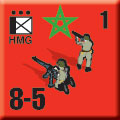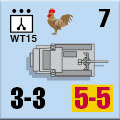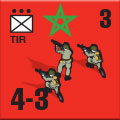Swallows of Death:
Scenario Preview, Part Six
by Mike Bennighof, Ph.D.
April 2023
 By the end of the 1940 campaign, the 1st Moroccan Division had ceased to exist, but Moroccan regiments continued to fight for France, and fight well. That’s the story of the final chapter of Panzer Grenadier: 1940: Swallows of Death, our expansion book all about Moroccan troops. By the end of the 1940 campaign, the 1st Moroccan Division had ceased to exist, but Moroccan regiments continued to fight for France, and fight well. That’s the story of the final chapter of Panzer Grenadier: 1940: Swallows of Death, our expansion book all about Moroccan troops.
While Panzer Grenadier is a fine game system, easy to play (as wargames go) with a very solid model of World War II tactical combat (within the restrictions of the “easy to play” part), it’s also an outstanding platform with which to tell stories. When done well, history tells a meaningful story. And I think we have just such a story with Swallows of Death.
You’re not going to find this story in many other places; Philippe Léonard conducted some pretty intensive research to uncover all of these battles. But it’s one that deserves to be told, and I’m deeply pleased that we’re the ones to tell it.
Let’s have a look at the scenarios from the sixth and final chapter.
Chapter Six
The Last Days
The German plan to attack France in May 1940 foresaw two stages. In the first, Case Yellow, they would overrun Belgium, the Netherlands and Luxembourg and drive into northern France, all while defeating the Allied forces defending there. Case Yellow went extremely well for the invaders; they had outflanked the fortifications of the Maginot Line, overrun those along the Franco-Belgian border, and defeated the French forces sent into Belgium to stop them, which included most of the French Army’s best units and had constituted their operational reserve. They now stood along the Somme and Aisne Rivers.

Moroccan tirailleurs receive awards for battlefield bravery.
France had not been defeated, however. The French still held Paris, still fielded 66 divisions, and still had most of their war industry – French factories had finally hit their maximum production by late May and now handed over 90 new tanks every week. But unknown to the Germans, while the French Army had recovered its will to fight, the French leadership had not. The newly-appointed Supreme Commander, Maxime Weygand, spoke of fighting not to defend France but to uphold the French Army’s honor.
Weygand’s pessimism did not extend to the Moroccan foot soldiers and horsemen. They had met and defeated the enemy already, and eagerly awaited the chance to do so again.
Scenario Twenty-Six
La Baraka
28 May 1940
Cerisy-Gailly, south of Albert
 The 10th Moroccan Tirailleur Regiment, part of the 7th North African Infantry Division (DINA), sent its II Battalion to defend the Somme Canal on 20 May. The Moroccans made it to their new positions without encountering the endemic German air attacks and ambushes; the men believed they had been protected by their baraka, that is, luck derived from a divine blessing. They took over defense of Cerisy-Gailly, a rather extended village bordered by large marshy areas, on the evening of 27 May, relieving a Tunisian unit. The Germans had infiltrated through the marshes; fierce house-to-house combat raged in the night and the Moroccans eventually withdrew. In early afternoon, they of course counter-attacked. The 10th Moroccan Tirailleur Regiment, part of the 7th North African Infantry Division (DINA), sent its II Battalion to defend the Somme Canal on 20 May. The Moroccans made it to their new positions without encountering the endemic German air attacks and ambushes; the men believed they had been protected by their baraka, that is, luck derived from a divine blessing. They took over defense of Cerisy-Gailly, a rather extended village bordered by large marshy areas, on the evening of 27 May, relieving a Tunisian unit. The Germans had infiltrated through the marshes; fierce house-to-house combat raged in the night and the Moroccans eventually withdrew. In early afternoon, they of course counter-attacked.
Conclusion
In the afternoon, the Moroccans initiated a furious counterattack against the positions just conquered by the Germans. They took back Cerisy one house at a time, killing 17 Germans and wounding 34 more. But the Moroccans paid a hefty price for the village. The 5th Company was reduced by half and one-fifth of the 6th Company was killed in action. However, the Germans had been chased off the left bank of the river.
Notes
The Moroccans are on the attack, with an edge in morale and a signification advantage in numbers. But as is usually the case, there is also much expected of them. It’s another fine opportunity to shout Allah Akbar and inflict some pain on the Master Race.
Scenario Twenty-Seven
Tank Destroyers
6 June 1940
South-east of Amiens, France
 Case Red kicked off on 5 June with an attack from the lower Somme area intended to reach the Seine River and then strike westwards towards the sea. At Hangest on the Somme, Erwin Rommel’s 7th Panzer Division hit the Senegalese defenses hard, finally bypassing the French hedgehogs after pausing to massacre 109 prisoners of war. Near Picquigny, the French 5th DINA was nearly destroyed during a long day of intense fighting. On the following night, the French withdrew slightly and organized a second defense line roughly parallel to the Somme River, between Camps-en-Amiénois and Fourdrinoy. On 6 June, the Germans launched a new attack to complete the breakthrough. Case Red kicked off on 5 June with an attack from the lower Somme area intended to reach the Seine River and then strike westwards towards the sea. At Hangest on the Somme, Erwin Rommel’s 7th Panzer Division hit the Senegalese defenses hard, finally bypassing the French hedgehogs after pausing to massacre 109 prisoners of war. Near Picquigny, the French 5th DINA was nearly destroyed during a long day of intense fighting. On the following night, the French withdrew slightly and organized a second defense line roughly parallel to the Somme River, between Camps-en-Amiénois and Fourdrinoy. On 6 June, the Germans launched a new attack to complete the breakthrough.
Conclusion
The panzers advancing rapidly towards the Seine River, forcing the French 13th Infantry Division to withdraw southward. The 54th BACA (Batterie d’anti-chars automoteurs, or Self-Propelled Anti-Tank Battery) had been formed on 30 May; the Lffley W15 tank destroyers they wielded had gone into production on 17 May with the first delivery on 25 May. The new battery deployed to block the Abbeville road, with one vehicle awaiting the Germans in the middle of the pavement. The French gunners quickly destroyed three Panzer IV tanks, then sped away. The Germans pursued, falling into an ambush by the rest of the battery, which destroyed ten more. The 54th BACA knocked out 18 panzers for the day, for the loss of one tank destroyer to mechanical breakdown and not a single man.
Notes
It’s a little late in the day, but finally the French have a weapon to defeat the panzers. Plus they have tanks and Moroccans. This is a large-scale tank battle scenario; they Germans have a hefty list of objectives and the French, well, they have tank destroyers.
Scenario Twenty-Eight
Pour l’Armée de Paris
12 June 1940
L’Isle d’Adam, North of Paris
 The defense of the Somme River line south-east of Amiens left the French 13th Infantry Division, including the 8th Moroccan Tirailleurs, much depleted with each regiment falling to the size of a battalion. The French Third Army Group attached the division to the Armée de Paris and dispatched it to defend the capital city behind the Oise River. That line of resistance, the Chauvineau Line, had received some fortifications during the thirties and French engineers quickly destroyed all bridges except for a footbridge on a lock, just north of the islands in the river. The division’s three depleted regiments set up on the river line; the first German attacks began on 11 June but all assaults were repulsed. The Germans attacked again on the next day, also in vain, but the shaken III Battalion of the Moroccan regiment began to withdraw from the island as the Germans slowly infiltrated the eastern river bank by crossing the footbridge at the lock. The defense of the Somme River line south-east of Amiens left the French 13th Infantry Division, including the 8th Moroccan Tirailleurs, much depleted with each regiment falling to the size of a battalion. The French Third Army Group attached the division to the Armée de Paris and dispatched it to defend the capital city behind the Oise River. That line of resistance, the Chauvineau Line, had received some fortifications during the thirties and French engineers quickly destroyed all bridges except for a footbridge on a lock, just north of the islands in the river. The division’s three depleted regiments set up on the river line; the first German attacks began on 11 June but all assaults were repulsed. The Germans attacked again on the next day, also in vain, but the shaken III Battalion of the Moroccan regiment began to withdraw from the island as the Germans slowly infiltrated the eastern river bank by crossing the footbridge at the lock.
Conclusion
A Moroccan counter-attack restored the French position, but at the cost of 112 men killed. The divisional artillery gave intense support – when the batteries were allowed to emplace themselves and prepare a fire plan, French artillery doctrine could be very effective. But while the 13th Infantry Division had held its lines, its neighbors had not, pulling back from the river on either flank. With both of its flanks uncovered, the division command had no choice but to order a retreat as well.
Notes
The Germans have the numbers at first, and have to get across the river. But then the French get more Moroccans, and have to throw them back. It’s not a very big scenario, but it does allow both sides to attack and defend, which is always a goods thing for repeated game play.

Moroccan tirailleurs clean their weapons.
Scenario Twenty-Nine
The Dauphin Crossroads
17 June 1940
Loury, north-east of Orléans
 After fighting hard on the Somme line, then on the Oise line, and then on the Orge line, the exhausted 13th Infantry Division tried to reach the Loire River using the last available bridges. But the German 33rd Infantry Division’s lead elements got there first, cutting the French retreat route with units guarding all of the crossroads. North of the city, in the forest of Orléans, the French 13th Infantry Division’s avant-garde still clung to Loury, at the Dauphin crossroads. After fighting hard on the Somme line, then on the Oise line, and then on the Orge line, the exhausted 13th Infantry Division tried to reach the Loire River using the last available bridges. But the German 33rd Infantry Division’s lead elements got there first, cutting the French retreat route with units guarding all of the crossroads. North of the city, in the forest of Orléans, the French 13th Infantry Division’s avant-garde still clung to Loury, at the Dauphin crossroads.
Conclusion
The French division’s lead elements had found the crossroads occupied by a handful of Germans. Over the next two hours, the German fire grew in intensity as reinforcements arrived. French field guns returned the fire at point-blank range. The fighting continued for several hours; a French attempt to overrun the crossroads with an enveloping movement was pinned to the ground by German defensive fire. Finally, around 0830 the Moroccans of the 1st Battalion of the 8th Tirailleurs made a desperate bayonet charge, screaming Allah Akbar! The Germans broke up and fled, and the French resumed their march towards the Loire. Unfortunately, the Germans had already occupied the approaches to the river and only 250 men would escape capture.
Notes
This is an odd scenario, with reinforcements arriving for each side in small allotments over the entire length of the game. That means that play will ebb and flow and first one side and then the other has the advantage. And finally, it’s another chance to scream Allah Akbar! while attacking with your Moroccans.
Scenario Thirty
First In, Last Out
24 June 1940
Annonay, south of Lyon
 The 1st Spahis Brigade had been the first to fight the Germans in Luxembourg in May. With the end of the Battle of France closing in, the Brigade was dispatched to Savoie, west of the Alp mountains. There, it stood on the west bank of the Rhône River valley, charged with delaying the German advance to the south. While the 6th Algerian Spahis watched the roads close to the Rhône, the 4th Moroccan Spahis set up roadblocks in the hilly region to the west, along the Cance River ravine. Calm at first, the sector grew lively as the German attacks along the Rhône River failed. The 1st Spahis Brigade had been the first to fight the Germans in Luxembourg in May. With the end of the Battle of France closing in, the Brigade was dispatched to Savoie, west of the Alp mountains. There, it stood on the west bank of the Rhône River valley, charged with delaying the German advance to the south. While the 6th Algerian Spahis watched the roads close to the Rhône, the 4th Moroccan Spahis set up roadblocks in the hilly region to the west, along the Cance River ravine. Calm at first, the sector grew lively as the German attacks along the Rhône River failed.
Conclusion
The Germans at first managed to gain a foothold, but soon enough the Spahis forced them back. Two more German attacks at 1700 and 1800, covered by heavy mortar fire, failed to make any headway despite desperate, hand-to-hand fighting. When darkness fell the French pulled back. Exhausted, the Germans did not pursue and fell back as well. During the night, an order arrived confirming the cessation of hostilities, and the Spahis headed for the Swiss border where they crossed into internment. They later returned to Vichy France, and in 1943 joined the Free French movement.
Notes
It’s the last day of the campaign, yet French morale still holds and they’re not in any mood to give ground yet again. The Germans have some light tanks to support their infantry, while the French have the Spahis.
And that’s all!
You can order Swallows of Death right here.
Please allow an additional three weeks for delivery.
Sign up for our newsletter right here. Your info will never be sold or transferred; we'll just use it to update you on new games and new offers.
Mike Bennighof is president of Avalanche Press and holds a doctorate in history from Emory University. A Fulbright Scholar and NASA Journalist in Space finalist, he has published a great many books, games and articles on historical subjects; people are saying that some of them are actually good.
He lives in Birmingham, Alabama with his wife, three children, and new puppy. He misses his lizard-hunting Iron Dog, Leopold.
Want to keep Daily Content free of third-party ads? You can send us some love (and cash) through this link right here.
|
